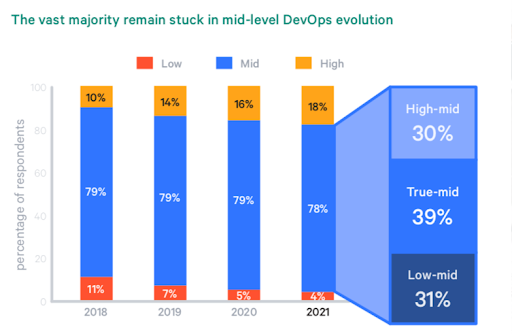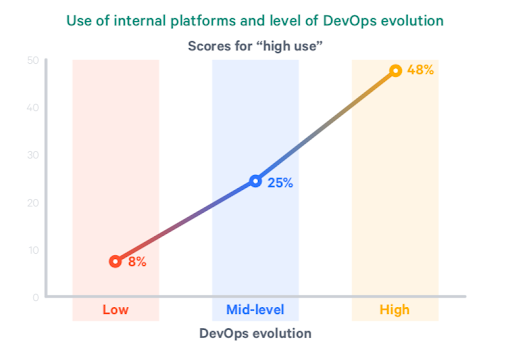Highlights From the 2021 State of DevOps Report

Highlights From the 2021 State of DevOps Report
Let's look at the takeaway points from Puppet's 2021 report, which focuses on key challenges faced by organizations and solutions to reach higher DevOps maturity.
The State of DevOps report released by Puppet each year is a great indicator of the pulse of the DevOps movement at the time. With its 10th edition, the report has continued to focus on the key challenges faced by organizations and solutions to them. This report digs deeper into these issues and provides great insight for organizations that want to move to higher levels of DevOps maturity. This post covers the key points of the report.
Stuck in the Middle
The report has previously shown the percentage of organizations in the low, mid, and high DevOps maturity, and usually, the midsection makes up the biggest chunk. This year is no different with 80% of organizations in the mid-level of maturity. Interestingly, this time the report breaks down this midsection into three sub-categories: low-mid, true-mid, and high-mid.

Source: Puppet
Organizations in the low-mid section are somewhat similar to low-maturity organizations, but with some differences. Similarly, organizations in the high-mid section resemble highly mature organizations but lack a few of their characteristics.
It's likely your organization is somewhere in the mid-maturity phase. It would help to further define your organization as low, true, or high-mid for greater clarity on what you need to work towards. The report offers numerous ideas on how to reach higher levels of maturity.
Team Identities Clearly Defined
Culture has been the predominant idea to describe DevOps for a decade now. However, that idea could be nebulous and get lost amidst all the focus on technology. This year's report brings culture back into focus and more clearly delineates what culture means at the ground level.
In practice, the key idea behind a successful culture is to have roles and responsibilities that are clearly understood by your own team and all adjacent teams. This includes having well-defined interaction paradigms and communication channels between teams.
This clarity is what results in a high degree of autonomy within teams, and makes it easy for teams to collaborate with each other when they do need outside help.
Two Types of Teams: Stream-Aligned and Platform
The report highlights a trend towards less ambiguous team names and is in favour of team names that are based on responsibilities. For example, in recent years there has been a decline in teams that identify themselves as "DevOps teams." This term is rather unclear. Instead, there are two types of teams that are emerging as more clear replacements: stream-aligned teams and platform teams.
Stream-aligned teams embody the phrase "You build it, you run it." These are usually the development teams that are responsible for building new features. Platform teams, on the other hand, exist to support stream-aligned teams and make resources available to them whenever needed.
Simply separating out a platform team doesn't inherently mean that an organization has achieved high DevOps maturity. However, the platform team approach is "key to escaping the middle phase" according to the report.
If you haven't begun a platform-based approach within your organization, now may be a good time to start. However, if you've been at it for a while and have had lackluster results, read on.
Platform as a Product
Platform teams deliver self-service APIs to consumers. They build and maintain the platform that is consumed by stream-aligned teams. The platform is a collection of self-service APIs, tools, services, knowledge, and support.

Source: Puppet
A key idea in the report is to treat the internal platform as an internal software product. They recommend using product management practices for internal platform development. The point is that you can't buy an internal platform — you build it from the ground up and tailor it to meet your organization's needs. One of the key purposes of adopting a platform approach is to enable greater developer velocity.
In fact, this idea was the central focus of last year’s State of DevOps report where "the top benefit of adopting the platform model, according to the report, is the ability to enable self-service capabilities for application development teams." It is in the interest of both application development and platform teams to enable a developer self-service experience. For developers, it results in a better developer experience and faster building of new features. For the platform team, it results in reduced manual effort, the ease of automated deployments, and peace of mind with security guardrails built-in. The key to achieving these much-desired benefits is GitOps.
More Than Infrastructure Automation
Automation has been a focus of DevOps since its early days. However, the report dives deeper into the types of automation and makes a distinction between them.
Automating repetitive tasks is absolutely necessary for organizations that want to move to higher levels of DevOps maturity.

Source: Puppet
The key difference lies in which parts are automated. Most organizations automate infrastructure components like self-service VM provisioning, and only a few automate developer components like observability and rate-limiting. The report encourages organizations to not stop at just infrastructure automation but to move to automate developer components as well. This involves a keen awareness of the various teams and their needs. DevOps automation has now gone beyond mundane instance creation and is reaching new heights.
Conclusion
The 2021 State of DevOps report by Puppet has touched on the important topic of culture and outlined practical solutions to changing culture in organizations. The two key ideas are to have clearly defined team names, roles, and responsibilities, and to leverage a platform approach. The key takeaway is that foundational concepts such as cloud, automation, and a platform are only the starting point and not a find in themselves. To achieve higher levels of maturity, how organizations approach each of them is what really matters.
If this post piques your interest, do give the entire report a read.
ZippyOPS Provide consulting, implementation, and management services on DevOps, DevSecOps, Cloud, Automated Ops, Microservices, Infrastructure, and Security
Services offered by us: https://www.zippyops.com/services
Our Products: https://www.zippyops.com/products
Our Solutions: https://www.zippyops.com/solutions
For Demo, videos check out YouTube Playlist:
https://www.youtube.com/watch?v=4FYvPooN_Tg&list=PLCJ3JpanNyCfXlHahZhYgJH9-rV6ouPro
If this seems interesting, please email us at [email protected] for a call.
Relevant Blogs:
Recent Comments
No comments
Leave a Comment
We will be happy to hear what you think about this post